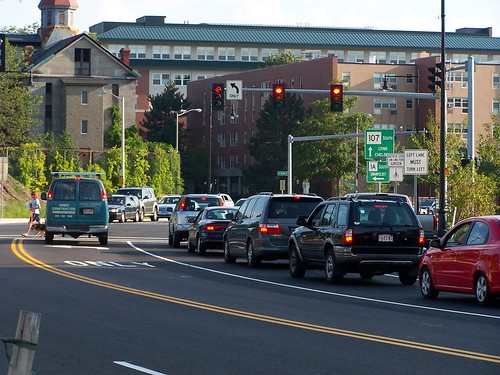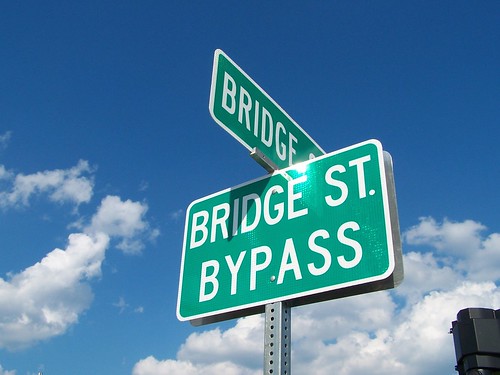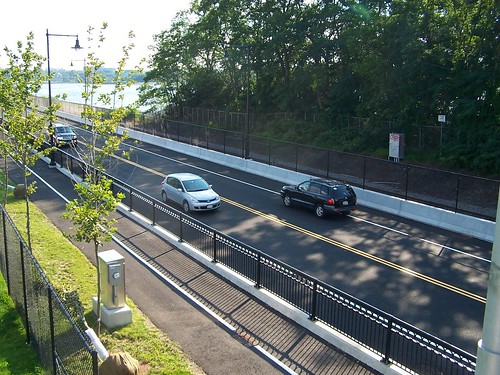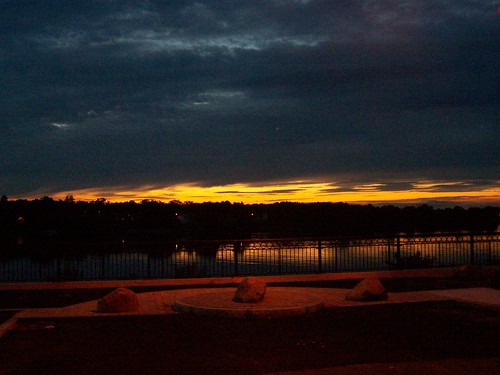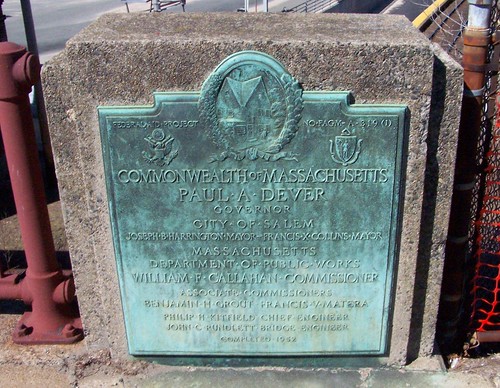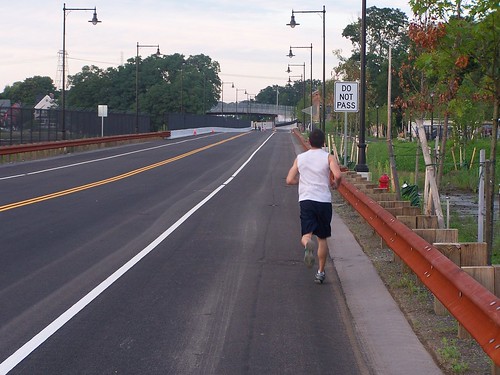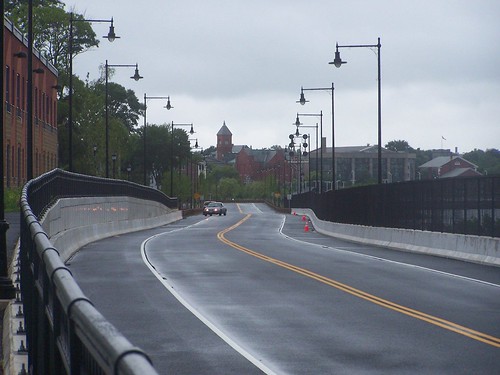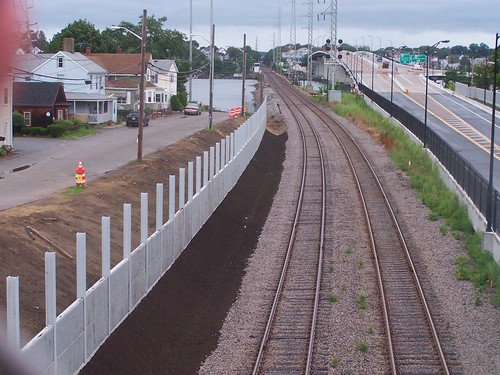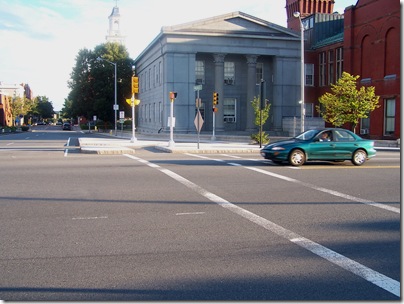
Lots of transportation developments for August! Besides the bypass road, there’s news all over, and out of, Salem in the past few weeks.
The North Shore is getting new MBTA buses. Historically, Lynn Garage (the center of MBTA bus activity here) has been one of the last garages to get new equipment. In 2004, we still had the old broken-down RTS buses, most of which were 16 years old, with the old flip-dot electronic signs I could never read.
The sting is not so bad this time, since the Neoplan buses that are currently in service are less than five years old and in good shape, if somewhat dirty. Most importantly, they have new LED signs I can read!
But I look forward to the new buses; I’ve seen them running the 455 today, so I’ll be on one soon.
Here's a hat tip to Beyond Red and Blue: Robert Sullivan wrote a post on Walk Score, applying that site’s walking score to various T stops. Responding to my post on Walk Score, Mr Sullivan says:
I found the walkability scores for all the stops on the Newburyport/Rockport line (see below), and Salem actually gets a 94 (out of 100), which is better than all of the Red Line stops in Dorchester and all of the Blue Line stops in East Boston. Salem gets a near-perfect score thanks to such nearby amenities as a movie theater, a "bookstore" (Harrison's Comics), and a "fitness" establishment (Body & Soul Massage).
The Walk Score data is, as they say themselves, incomplete; there are two full-service bookstores nearby (Cornerstone Books and Derby Square Book Store) and of course, the Y.
The worst score I've come across so far is Rowley Station, which gets a single-digit 6. Chelsea and Lynn each get a 75, which says something about how underserved those areas are despite having very dense populations.
I had thought Newburyport would be the worst score since it’s so far from downtown, but Rowley is truly a bedroom-community stop. In Lynn, Central Square has been rundown for decades, and a sad story of decline and city mismanagement.
Salem is paying attention to pedestrians at long last. A Globe North article from a few weeks ago, “Salem joins effort to steer commuters away from cars” explains:
Salem is a great walking city, and residents and people who work there have traditional transportation options: commuter rail, bus line, Salem State shuttle, and a ferry to Boston.
But its roads still overflow with traffic, particularly at peak periods.
So it's not surprising that the city became the first municipal partner for the North Shore Transportation Management Association, a new group that is trying to reduce gridlock and the region's carbon footprint through alternative commuting methods.
"It seems like it's a perfect time to be looking at those things," Mayor Kim Driscoll said. "We don't have anything in our region that asks, 'How do we get to employment sectors? How do we get to places where students are going? Is there a better way to get people to where they want to be, that's good for them, saves them money, and also helps the environment?' I think there are a lot more options for us to think about."
I’m glad the Driscoll administration is making this shift away from car-centrism; it’s been delayed for too long, but it seems to be finally coming after years and years of lip service and inaction.
According to a press release I got from the mayor’s office, the city is fixing some curb cuts in and around downtown:
City Works to Improve Accessibility in the Downtown
SALEM, MA – This week, the City of Salem’s Department of Public Services is working to improve the accessibility in and around the downtown for disabled individuals who live or visit the City.
The Department of Public Services has hired Marchese and Sons Construction to make sidewalk and ramp improvements in several areas within the City’s extended downtown area. Close to 20 curb cuts that have been identified as problematic for individuals with disabilities are being completely reconstructed to make it easier for people to traverse.
“While many improvements still remain, this round of construction is a great start to ensure that all individuals feel welcome in our City and can navigate in our downtown safely,” stated Mayor Driscoll. “I am pleased that the Department of Public Services has made this work a priority.”
New ramp curb cuts are being installed at the Public Library crosswalk where no curb cut had existed before; Essex Street at Hamilton, Beckford, Cambridge and Barton Square; Washington Street at Church and Lynde Streets; the crosswalk at 27 Charter Street (Salem Housing Authority senior housing complex); and at 60 Washington Square.
I’ve seen them working at North & Essex Sts., a known problem area, and had assumed it was related to courthouse work. It’s excellent news!
But the city shouldn’t stop there.
One of Andy LaPointe’s pet causes, and now my pet cause, was to get the new-style talking audible signals in Salem. I’ve talked about this too many times to mention. We have these at Salem State College Central Campus, Vinnin Square, and Marlborough Road.
But not on Bridge St. at the train station. Nor at St. Peter St. (this last one was promised by Sue Cranney, project manager for the bypass road, in my presence.)
I suggest a project for the new association: Get new audible signals—not the buzzer or the chirping models—throughout downtown Salem, and other pedestrian-heavy areas on the North Shore.
Finally, a trolley story in the Times: Downtowns Across the U.S. See Streetcars in Their Future - NYTimes.com. Cities like Cincinnati are trying to get new trolleys. When I was in Cincinnati on a business trip 10 years ago, people were just beginning to kick the idea around. At that time, they had a “Big Dig” project of their own underway, Fort Washington Way. There seems to be a sense there, as there has long been in Boston, that there’s no more room for new road projects.
I just wonder what planet the Times is on. How can people embrace the great cost and disruption of construction for trolleys, when, as I’ve wrote before, any such project in Massachusetts would die of learned helplessness (“It costs too much!” “It destroys the character of the city!” “It lowers my property values!” “It brings those people here!”)
Next up: Bypass road opens Monday and the courthouse traffic project reaches an important milestone as the old east ramp off Bridge St. is permanently closed, tentatively scheduled for Wednesday the 21st.
